Oligomyrmex (Aneleus) politus (Santschi)
Minor -   Type location Kenya (Aneleus
politus n. sp., Santschi, 1914b: 79, illustrated, minor; Consani,
1951:
170, queen; placed in Oligomyrmex
by Ettershank, 1966: 124) Blue Post Hotel, Kikuyu, i.1912 - see below. Type location Kenya (Aneleus
politus n. sp., Santschi, 1914b: 79, illustrated, minor; Consani,
1951:
170, queen; placed in Oligomyrmex
by Ettershank, 1966: 124) Blue Post Hotel, Kikuyu, i.1912 - see below.
subspecies nicotianae (Sporocleptes
nicotianae n. sp., Arnold, 1948: 220, illustrated, worker) from Zimbabwe
- no images on Antweb (February 2015).
junior synonym villiersi (see below for details) and images.
Minor and queen only described (see Bolton, 1995)  . .
Almost certainly also the senior synonym of Oligomyrmex punctatus.
|
 Santschi's
(1914b) description is at Santschi's
(1914b) description is at  . Consani's (1951) description of the queen
is at . Consani's (1951) description of the queen
is at  . Arnold's (1948) description of nicotianae
is at . Arnold's (1948) description of nicotianae
is at  . .
Bernard's (1952) description, with his genus definition,
as Nimbamyrma, is at  . From his description it seems very likely
this worker is a simple junior synonym of politus - see below. . From his description it seems very likely
this worker is a simple junior synonym of politus - see below.
|
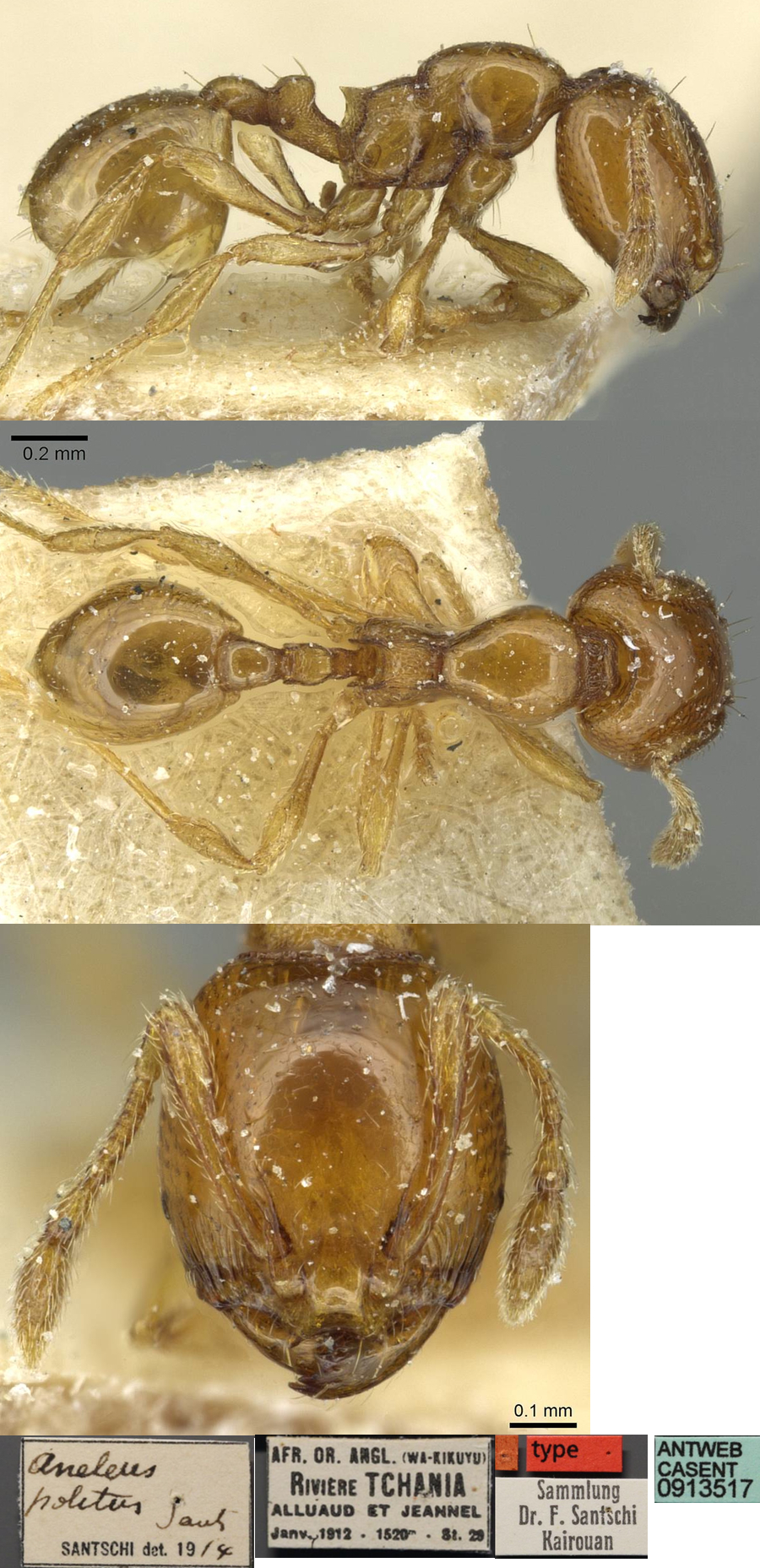 The
photomontage of the type worker is collated from http://www.antweb.org/specimen.do?name=casent0913517 The
photomontage of the type worker is collated from http://www.antweb.org/specimen.do?name=casent0913517
|
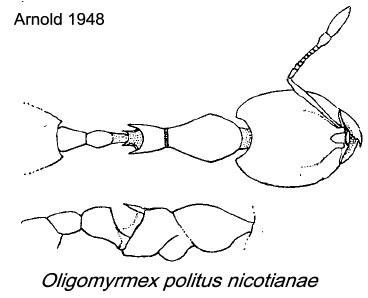 There seems a strong possibility that this could be
separable as a distinct monotypic Genus. Both Arnold (1948: 220)
and Bernard (1952: 240) suggested that was the case. Curiously despite
several collections, from Kenya, Zimbabwe (nicotianae), Guinea (villiersi,
Bernard) and Nigeria (below), there has been no definite finding of a
major morph. Bernard (1952) also refers to numerous subterranean
workers (of Nimbamyrma) having been collected in Angola.
Moreover, the size of the reported queen (Consani, 1951) at TL 10 mm is
quite remarkable for the genus Oligomyrmex. The queen of paetus
(above) is TL 4.5 mm, and of perpusillus arnoldi is TL 3.8 mm.
The few descriptions of Oligomyrmex queens all describe the
morphology as similar to that of the soldier, particularly that the
head is rectangular, somewhat longer than wide. The head of Consani's
queen is quite different (see comparative illustration below), being
much more like that described for Carebara queens, as much
wider posteriorly and at least as wide as long, often wider. There seems a strong possibility that this could be
separable as a distinct monotypic Genus. Both Arnold (1948: 220)
and Bernard (1952: 240) suggested that was the case. Curiously despite
several collections, from Kenya, Zimbabwe (nicotianae), Guinea (villiersi,
Bernard) and Nigeria (below), there has been no definite finding of a
major morph. Bernard (1952) also refers to numerous subterranean
workers (of Nimbamyrma) having been collected in Angola.
Moreover, the size of the reported queen (Consani, 1951) at TL 10 mm is
quite remarkable for the genus Oligomyrmex. The queen of paetus
(above) is TL 4.5 mm, and of perpusillus arnoldi is TL 3.8 mm.
The few descriptions of Oligomyrmex queens all describe the
morphology as similar to that of the soldier, particularly that the
head is rectangular, somewhat longer than wide. The head of Consani's
queen is quite different (see comparative illustration below), being
much more like that described for Carebara queens, as much
wider posteriorly and at least as wide as long, often wider.
Bolton (1995: 299) refers to Arnold (1952a: 460) as
recognising nicotianae as a subspecies of politus.
Consani (1951) has a note that Arnold, in a letter, synonymized Sporocleptes
under Aneleus. When Arnold (1952a) is examined, however, this
synonymy is justified as -
"Mr William J Brown (Harvard University) has
drawn my attention to the close similarity between Sporocleptes
nicotianae Arn., and Aeneleus politus Sant., .... and has
suggested there probably is a synonymy. He also kindly sent me a
specimen of Aeneleus politus, collected at Blue Post Hotel,
Kenya, and determined by Menozzi".
"A comparison of this specimen with Sporocleptes nicotianae
proves that Sporocleptes must be placed in synonymy with Aneleus,
and that nicotianae may be regarded as a race of politus,
from which it differs as follows. The head is much less convex
transversely, the epinotal [propodeal] teeth are longer, the sides of
the epinotum are reticulate, the apex of the node of the petiole is
wider, and the colour is much paler. Santschi's figure is inaccurate,
as the membranous extension ventrad of the epinotal spines has been
omitted".
|
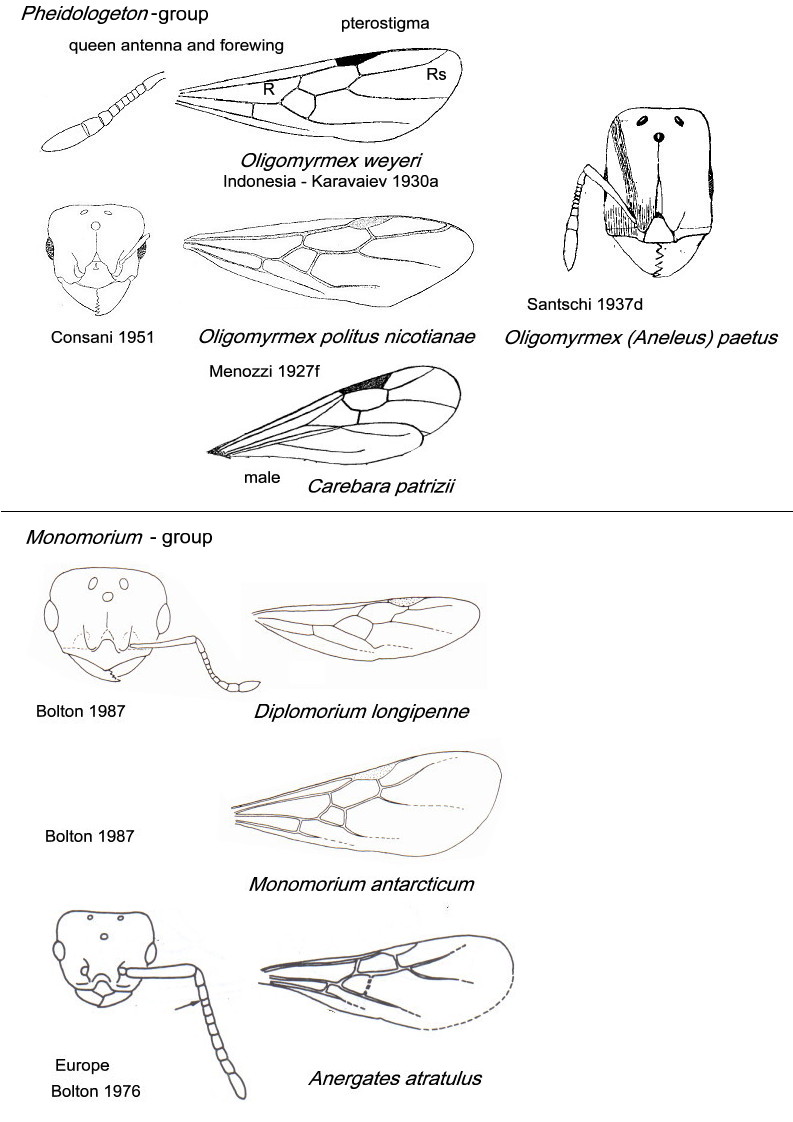 To me, all that shows is that the single specimen
designated Aneleus politus by Santschi, the specimens
designated S. nicotianae by Arnold and the specimens designated
Nimbamyrma villiersi, and so-on, are variants of a
single pan-African species. Arnold does not seem to have considered
whether or not his recognition of a new genus was correct and that it
was Santschi who was in error in placing it in Aneleus. To me, all that shows is that the single specimen
designated Aneleus politus by Santschi, the specimens
designated S. nicotianae by Arnold and the specimens designated
Nimbamyrma villiersi, and so-on, are variants of a
single pan-African species. Arnold does not seem to have considered
whether or not his recognition of a new genus was correct and that it
was Santschi who was in error in placing it in Aneleus.
Bolton (1987) refers to the Pheidologeton group
of Myrmicine genera as including Anisopheidole Forel (a
monotypic Australian genus), Carebara
Westwood, Lophomyrmex Emery (an Oriental, Indo-Australian
genus), Oligomyrmex, Paedalgus
Forel (queens have TL range 5.4-6.9 mm, HW = HL;with associated workers
TL 1.4-1.6, Bolton & Belshaw, 1993) and Pheidologeton.
Bolton & Belshaw (1993) considered that the monomorphic Carebara
and Paedalgus possibly could be combined in a single genus,
comparing them with Oligomyrmex which they declared as having
all its known species being dimorphic in the worker. They noted also
that Carebara and Paedalgus differ from Oligomyrmex
in having queens which are far larger than the minor workers (e.g. Carebara
vidua - queen TL 24 mm, minor TL 1.6-2.0 mm).
The wing structure of Consani's queen, however, is
typical of a Pheidologeton-group member, having a closed cell
where Rs joins R. Until further evidence arises to confirm that the
queen described and illustrated by Consani is actually that of politus
the Genus question must remain open.
|
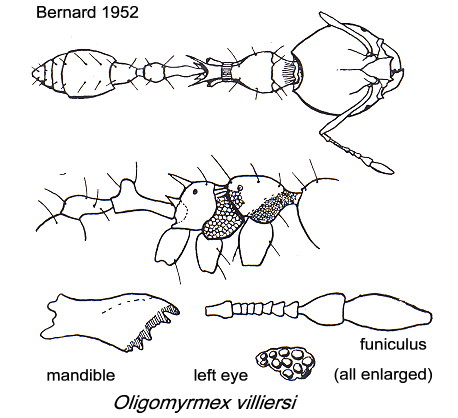
Oligomyrmex (Aneleus) villiersi (Bernard)
Minor - 
Nimbamyrma villiersi
n. sp.
TL 1.8 mm; colour bright
yellow, very shiny, with almost no puncturation or sculpturation other
than striated or reticulated areas on the thorax. No pubescence, short
hairs on the appendages; raised sensory hairs, no more than 4 per
segment on the head, thorax and abdomen. Head gross, very rounded, a
little longer than wide. Occiput scalloped, concave and lightly
bordered. Clypeus large, triangular, median border rectilinear, armed
with two lateral teeth. Mandibles stout, slightly arched, with 4 large
teeth and 2-3 denticles; palps very short. Eyes level with the base of
the scapes, black, miniscule, with 9-11 discontinuous facets. Antennae
slender with the scape not reaching the vertex; funiculus of 10
segments, only 2-6 wider than long. Thorax slender, anterior bordered,
striated thereafter; generally smooth; fine reticulation on prosternum;
mesosternum and mesopleuron more so; strong longitudinal striae on
metanotal groove. Propodeum short with two strong teeth, plus two
shorter inferior teeth. Petiole and postpetiole very long and slightly
elevated. Gaster small.
 Type location Mt. Nimba, Guinea,
two minors only, from the north-east forest, leaf litter sifting by
Villiers, ix.1946 (Nimbamyrma villiersi, Bernard, 1952: 241,
illustrated, minor); minor only described (see Bolton, 1995). Type location Mt. Nimba, Guinea,
two minors only, from the north-east forest, leaf litter sifting by
Villiers, ix.1946 (Nimbamyrma villiersi, Bernard, 1952: 241,
illustrated, minor); minor only described (see Bolton, 1995).
|
 The
photomontage of the villiersi type worker is collated from http://www.antweb.org/specimen.do?name=casent0913514 The
photomontage of the villiersi type worker is collated from http://www.antweb.org/specimen.do?name=casent0913514
|
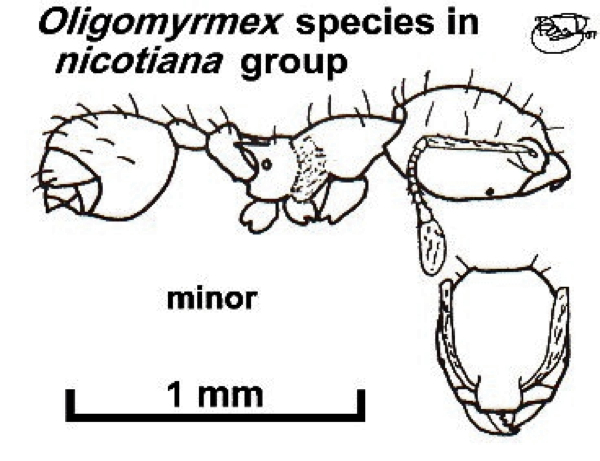
Nigeria specimens (Pheidologeton species
in Taylor, 1980a: 41). Only a single morph was present in the CRIN
collection, presumed to be a minor. TL 1.87 mm, HL 0.53, HW 0.47, SL
0.39, PW 0.26
Colour golden yellow. Unsculptured except for slight
reticulation on the lateral mesonotum. Erect hairs relatively long and
sparse. Propodeal spines long, narrow and acute; promesonotal suture
absent; petiole and postpetiole with laterally compressed nodes.
Found in leaf litter at the Cocoa Research Institute of
Nigeria, Idi Ayunre, by B. Bolton, who determined the generic status
(personal communication, 1976).
|
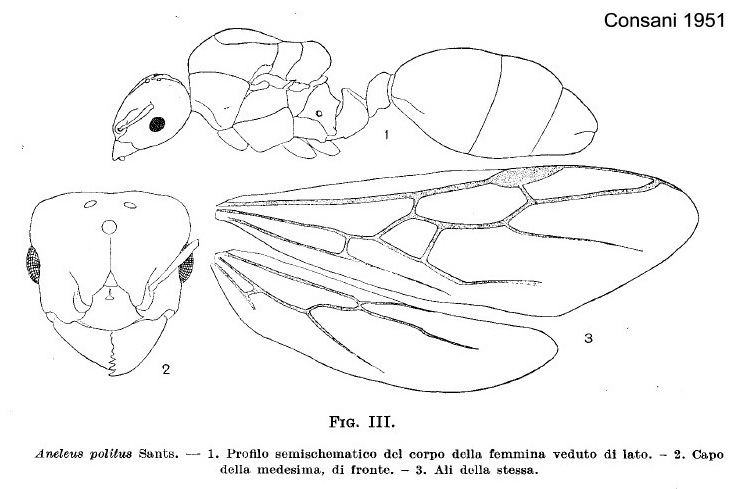 The illustration of a
queen is from Consani (1951). The illustration of a
queen is from Consani (1951).
From the limited information available, this is close to
the queen of Oligomyrmex longii
Wheeler [Carebara longii
in Fernandez, 2004] http://www.antweb.org/specimen.do?name=casent0103521
[Erebomyrma longii, Wheeler, 1903a: 140; placed in Oligomyrmex by Ettershank, 1966:
123) type location USA.
Note: A queen is shown at http://www.antweb.org/specimen.do?name=casent0217139
with the species name given as Carebara polita.
This bears no resemblance to the Consani illustration. It also poses a
question as to size because the scale lines on the three photographs,
lateral, dorsal and head, give different sizes for the head width (the
only directly comparable parameter).
|
From his examination of specimens sent to him by B
Bolton (location not given but, by
deduction, includes some from Bolton's Nigeria finding) and others seen
at the MCZC (no location given), Fernández (2010) placed Nimbamyrma villiersi in Carebara but appears to have been
unaware of the close similarity with the prior named O. politus.
I
have collated the images shown above with those given
by Fernández. The montage shown below shows the available images. The
photographs match the drawing I made in 1976 and Fernández confirmed
that the Bernard drawing exaggerated the metapleural
process. Now (February 2015) the availability of type images (above)
confirm the negligible differences between politus and villiersi.
|
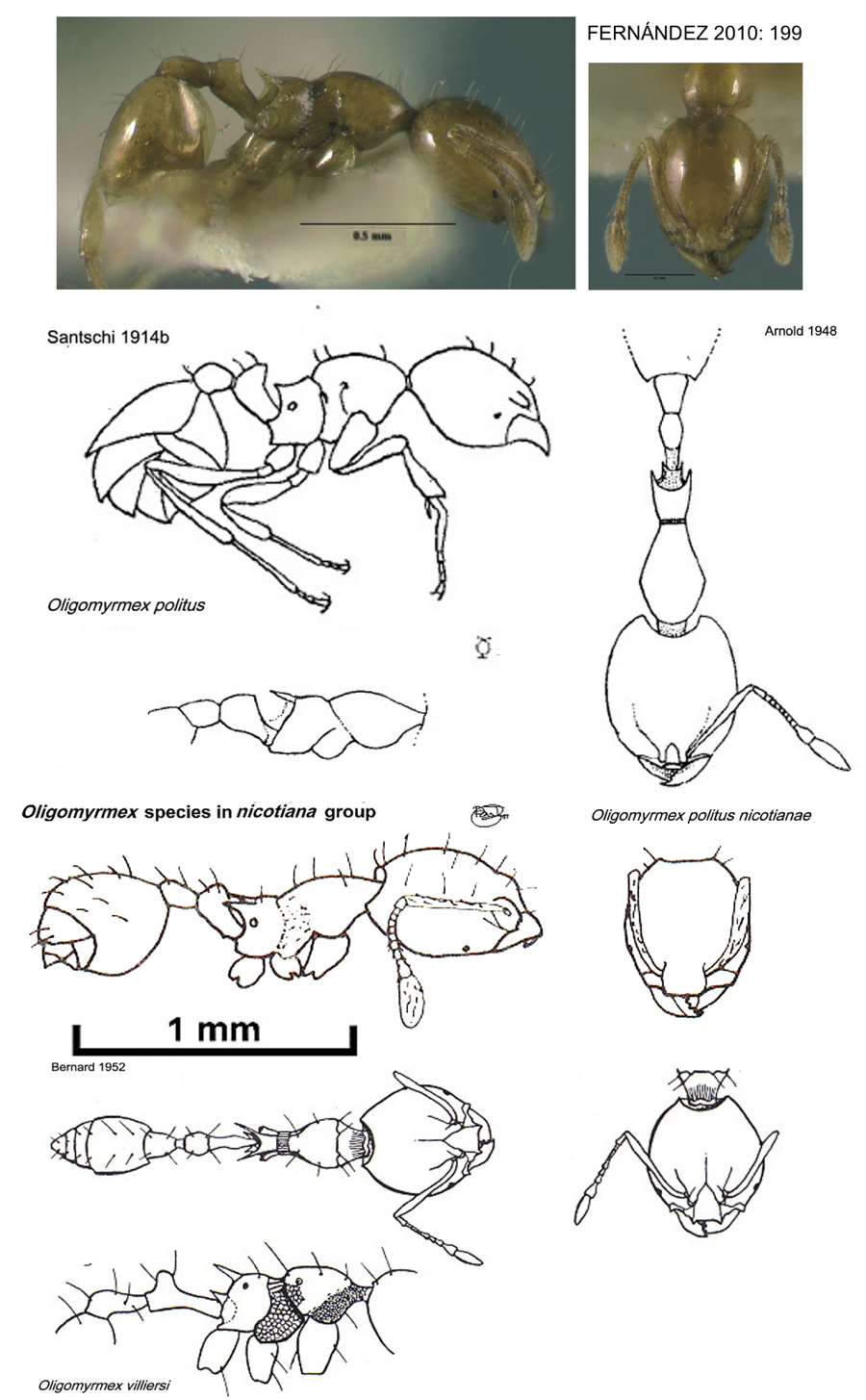 |
|